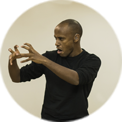Recruiting Body in Reference Tracking in Sign Language
Rose Stampi,ii, Svetlana Dachkovskyi,iii, and Wendy Sandleri
iUniversity of Haifa, iiBar Ilan University iiiGordon Academic College of Education
Speakers and signers use an array of sophisticated strategies to track reference to discourse entities. The degree of explicitness of the reference depends on whether the referent is new (e.g., first mention) or given (e.g., reintroduction or maintenance of a previously mentioned referent). One means of signaling information status is the choice of referring expressions. For example, we may introduce a character with a noun phrase ‘the girl’ and later refer back to the same character by using a pronoun ‘she’. The second means of signaling information status is phonetic reduction (e.g., shortening and merging previously introduced referents).
Our project addresses both aspects of reference tracking over two studies: one investigating how different strategies of reference tracking emerge in a young sign, and the second investigating phonetic reduction of reference in a narrative. The findings of the first study indicate that early on, signers favour both lexical symbols and mimetic use of the body for reference. Over time, more abstract structures with more simultaneous complexity increase. In the second study, which uses sophisticated motion tracking technology, we find that a number of kinematic characteristics (i.e., sign duration, volume) differ depending on the referent status. The overall results indicate that predictable information is less explicitly marked even in a young sign language, suggesting that this is a universal communication-based phenomenon.







